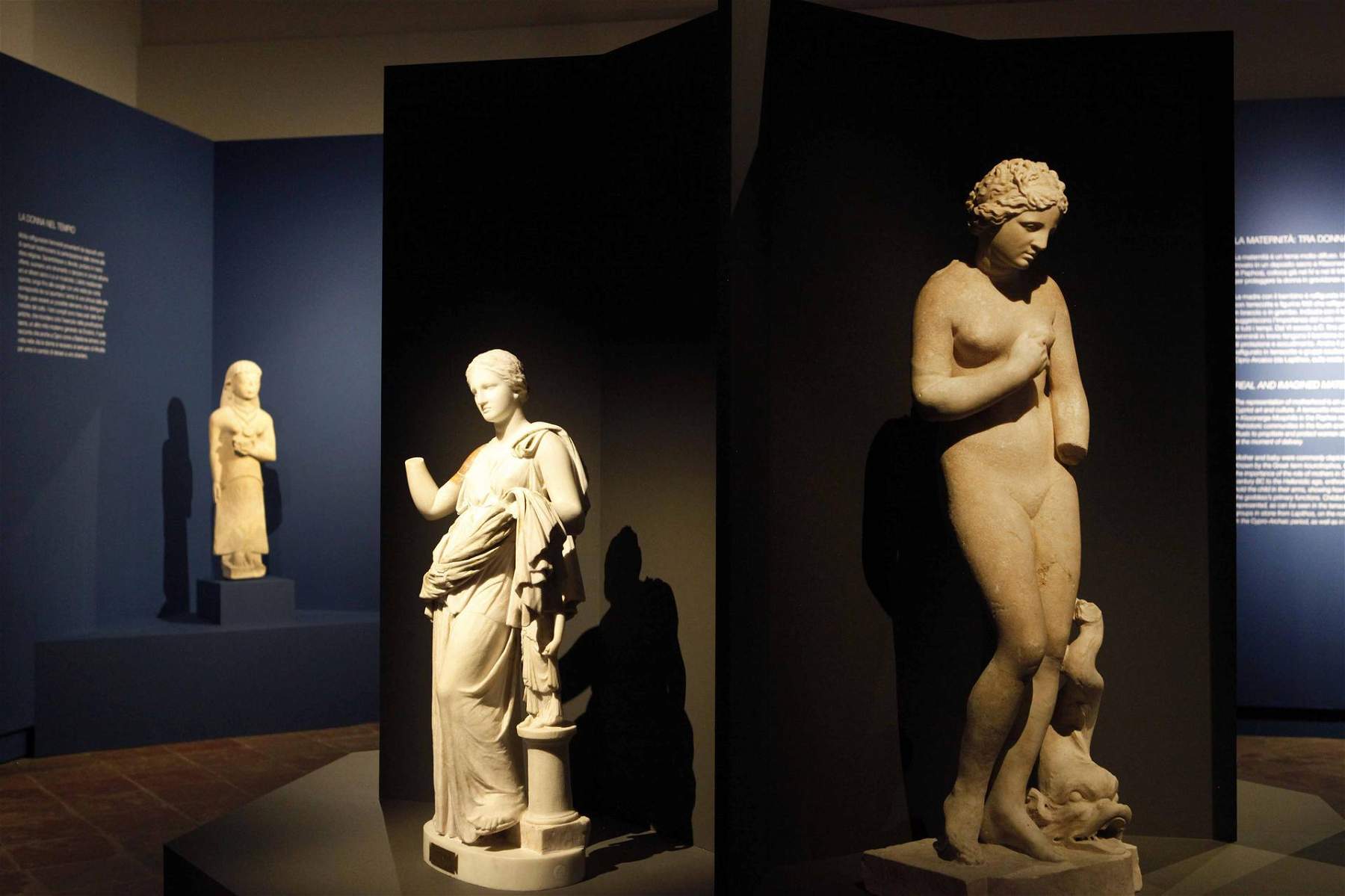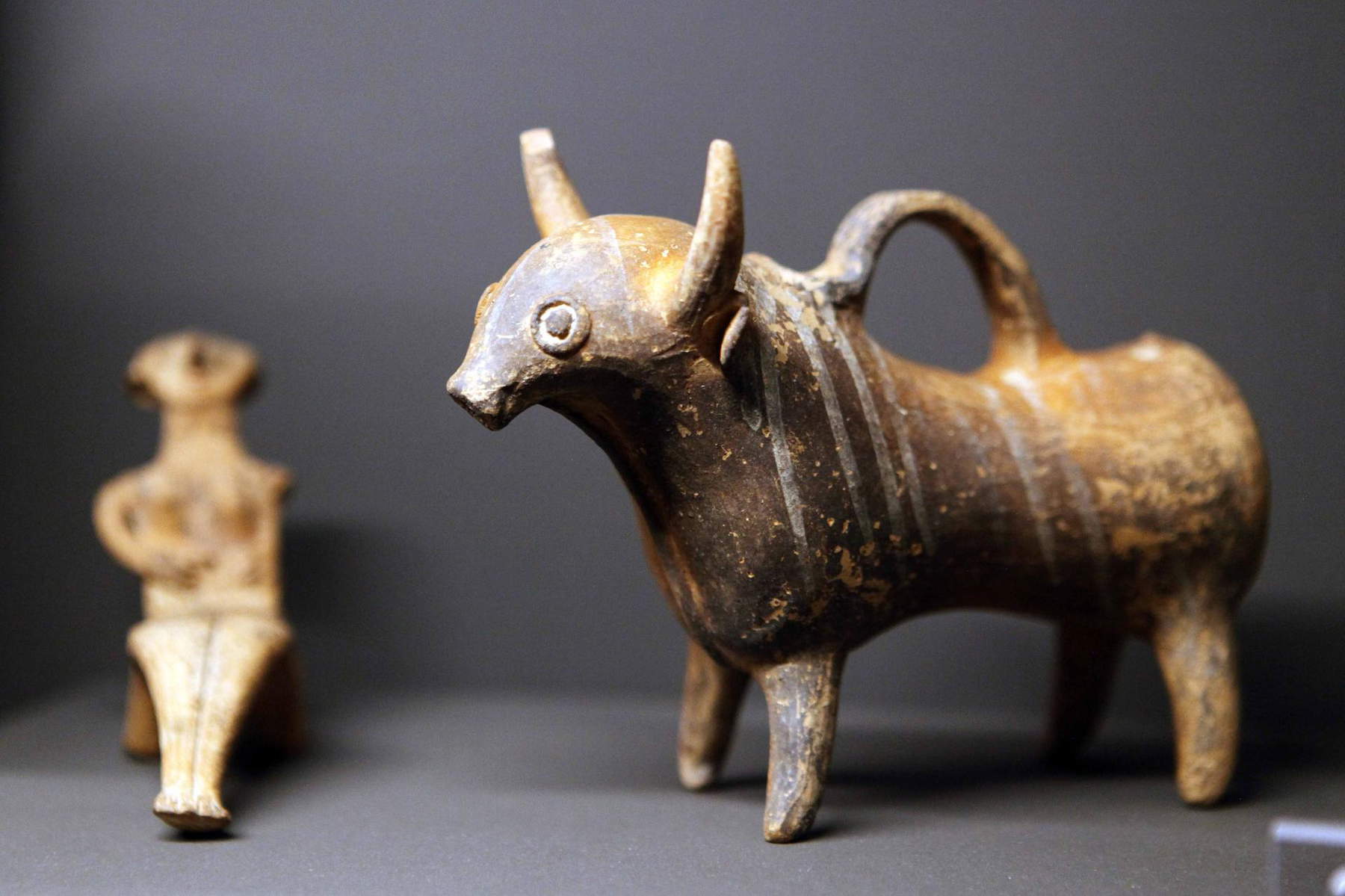From June 29 to Jan. 9, 2022, the Sale Chiablese of the Royal Museums in Turin will host an exhibition dedicated to the millennia-long history of Cyprus, the heart of the Mediterranean and the bridge between East and West. Entitled Cyprus. Crossroads of Civilizations, produced in collaboration with the University of Turin, with the patronage of the City of Turin and the Piedmont Region and the support of Fondazione CRT, Reale Mutua, Jubilee and Ribes Solutions. Curated by Luca Bombardieri, a professor at the University of Turin, and Elisa Panero, curator of the archaeological collections of the Royal Museums, the exhibition traces the ancient history of the mythical cradle of Aphrodite, a crossroads of trade and a landing place for different cultures in which the modern conception of the Mediterranean world was formed.
The exhibition is delineated around Italy’s most important Cypriot collection, that of the Royal Museums of Turin, largely unpublished to date, and is enriched by unique loans for the first time in Italy from distinguished foreign institutions, including the British Museum in London, the Metropolitan Museum of Art in New York, the Fitzwilliam Museum in Cambridge, the Medelhavetmuseet in Stockholm, the Kunsthistorisches Museum in Vienna and the Cyprus Museum in Nicosia.
The Cypriot collections of the Royal Museums of Turin constitute an almost unique nucleus in the panorama of major European museums. In fact, the Museum of Antiquities has more than 1,000 artifacts, the result of donations that have taken place since 1847 under the consul of the Kingdom of Sardinia Marcello Cerruti first and especially thanks to excavations conducted by Luigi Palma di Cesnola, an American consul on the island but born in Rivarolo, in the province of Turin. This collection is comparable in scientific importance and variety to the great collection of the Egyptian Museum in Turin, of which it represents an ideal Mediterranean counterbalance. The Turin collection, the oldest outside the island and probably also the most complete in chronological terms, constitutes at the same time the alter ego of the Cypriot collection set up at the Metropolitan Museum of Art in New York by Luigi Palma di Cesnola himself, as its first director.
“With Cyprus. Crossroads of Civilizations the Royal Museums take a decisive step in the field of research and around a very significant segment of the archaeological collections related to the Savoy legacy,” says Enrica Pagella, Director of the Royal Museums. “Despite the delays and restrictions due to the health emergency caused by the pandemic, the exhibition is now being offered to the public in a configuration faithful to the original project, thanks above all to the willingness of the museums and lending institutions, which have ensured a valuable continuity of collaboration. To them, and, together, to the University of Turin, goes our most sincere thanks for believing in this project and supporting it even during the long months of uncertainty that accompanied its gestation.”
“The Royal Museums are trying their hand at a major international exhibition of archaeology, a theme that has been missing from the Turin scene for more than a decade, and they are doing so with a cross-cutting and choral narrative,” explain curators Elisa Panero and Luca Bombardieri. “In the ancient imagination, Cyprus is inextricably linked to Aphrodite. The birth of the Goddess and her relationship with her island of choice have formed, through the centuries and the different forms of literary and artistic expression, an image of Cyprus so strong that it transcends myth and influences our modern perception of this island’s history. But Cyprus goes beyond its Goddess. Modern archaeological research has made it possible to restore its dimension as the heart and crossroads of the Mediterranean and its role as the fulcrum of a horizon that extends to the entire Mediterranean. A bridge and a port, to which we hope the Turinese, Italian and international public with a curiosity to explore the origins of our European identity can land.”
 |
| Images from the exhibition |
It is only in recent decades that recent archaeological studies have made it possible to restore the island’s identity, its decisive role in Mediterranean trade and its thousand-year path of development. Cyprus was, in fact, a key stopover for ancient navigation: from the Bronze Age onward it confirms its nodal role in contacts with the Near East, first with the presence of the Phoenicians, then with the Assyrian, Egyptian and Persian dominations up to the Roman one. The Cypriot heritage appears as a mixture of different patterns and influences, languages and knowledge, harmonizing into a wholly original and highly distinctive culture.
Cypriot civilization is brought to life in the exhibition through the stone and terracotta sculptures, ceramics and alabasters, glass, metals, oil lamps and jewelry, as well as mirrors, epigraphs, seals and coins on display in the spaces of the Chiablese Rooms. Here the exhibition is modulated along a path that begins with 19th-century collecting and scholarly research in Turin and Europe, outlining the cultural context that led to the formation of the Museum of Antiquities’ important collection, and returns to the Savoy capital with the most recent updates and lines of research in current scientific archaeology. Seven thematic sections aim to frame the materials in the history and myth associated with the island, not only tracing chronologically the events that led from the first prehistoric settlements to the formation of the city-states and the period of the great empires, but also exploring the cults, symbols and typical rituals as well as the contaminations between languages, scriptures and power. Special attention is paid to the role of women in all its expressions, with statues, jewelry and paintings from the Galleria Sabauda, which dialogue with older depictions defining new meanings. Interactive multimedia installations and multisensory experiences involving smell and hearing enrich the visit, which ends with the return to Turin, the place of departure and at the same time of arrival of a journey that in its final part focuses on what has been discovered and brought to light by the most recent Italian missions to Cyprus. A contribution that allows the visitor to find the evolution of the archaeological discipline through 3D reconstructions and computer instrumentation, interacting through tactile experiences that guide the understanding of archaeology as conceived today.
Among the most significant exhibits are a number of artifacts housed at the Museum of Antiquities, including a small terracotta head of a deity or priestess dating from 625-550 B.C.; a date-shaped, glass ointment jar from the early imperial age, probably containing an oily substance made from the tropical fruit; and a statue of the goddess (Aphrodite) seated on a throne, which arrived in Turin in March 1847, and whose body and head date from different ages, mounted together in accordance with a custom characteristic of antiquarian collecting at the time. Arriving instead from Vienna is a statue of a goddess seated on a throne from the Cypro-Archaic period, on loan from the Kunsthistorisches Museum, while from The Metropolitan Museum of Art in New York a votive statue in Assyrian dress, in limestone, dated between 550525 B.C., is on public display for the first time. Ample space, finally, is also devoted to collaborations with Italian and Piedmontese institutions, in particular: the Egyptian Museum in Turin; the Academy of Sciences in Turin; the Historical Archives, the Museum of Anatomy and the Museum of Anthropology and Ethnography of the University of Turin; and the Camillo Leone Museum in Vercelli in addition to the National Archaeological Museum in Cagliari.
 |
| Images from the exhibition |
The opening of Cyprus. Crossroads of Civilizations was preceded by the publication of a podcast created by students of the Holden School with the coordination of author and director Alessandro Avataneo. Starting from some of the artifacts in the exhibit and from the dialogue with the archaeologists, the young storytellers told in ten episodes the relationship between Cyprus and Piedmont, between the Palma brothers of Cesnola and contemporaneity, through the eyes and words of an unseen Mediterranean.
In addition, the public will have the opportunity to expand the visiting experience by participating in the many side activities that will enliven the coming months. From July 16 to Aug. 27, every Friday at 9 p.m. except Saturday, Aug. 14, the court and gardens of the Royal Museums will host a series of concerts, Turin. Crossroads of sonorities, in collaboration with the Giuseppe Verdi State Conservatory of Music of Turin. Winds, percussion, strings and guitars will accompany listeners on a musical journey that takes Turin to the center of different sounds from the Mediterranean and across the ocean, as Luigi Palma di Cesnola did in the mid-19th century, to American jazz. Those who attend the concerts will have the opportunity to enjoy, in a unique dedicated package, the evening visit to the exhibition, which is open extraordinarily until 11:30 pm.
The exhibition also counts on an exceptional collaboration for the reconstruction of the ancient sounds: the Turin band Eugenio in Via di Gioia has also been fascinated by the archaeological journey to the land of Aphrodite, collaborating with the curators to reconstruct and interpret the ancient sounds that will be appreciable within the space dedicated to the Sacred, the goddess and her myths. From July 17, it will also be possible, walking through the shady avenues of the Royal Gardens, to get to know the essences by “sailing” to Cyprus. The island, the greatest producer in antiquity of perfumes dedicated to the goddess Aphrodite, will be shown to visitors through multisensory and olfactory experiences: small groups will be led to discover ancient fragrances, on a journey through the centuries between East and West. In addition to guided tours by reservation in Italian, English, French, German and Spanish, to promote an increasingly accessible enjoyment of the Museums, a series of guided tours in LIS Italian Sign Language is planned, which will provide an opportunity for the deaf and hard of hearing to approach the exhibition in an inclusive and participatory form.
 |
| Images from the exhibition |
 |
| Images from the exhibition |
The exhibition opens from Wednesday, June 30, 2021 to Sunday, January 9, 2022, Tuesday through Sunday from 10 a.m. to 7 p.m. (last admission 6 p.m.). Tickets: full 15 euros, full Cyprus + Royal Museums 25 euros, Reduced (Groups with reservations, teachers, conventions) 13 euros, Reduced visitors 11 to 25 years 7 euros, Reduced visitors 11 to 25 years Cyprus + Royal Museums 7 euros. Free for under 11, teachers with school groups, tour guides, Ministry of Culture staff, ICOM members, disabled and accompanying persons, holders of Abbonamento Musei, Torino + Piemonte Card and Royal Card. Admission for visitors over 65 is provided at regular rates.
Reservations (in addition to ticket cost): groups 15 euros, schools 10 euros. Educational activities Groups (max 15 people) 60 euros, educational activities Schools (max 15 people) 55 euros, workshop Schools (max 15 people) 80 euros. Guided tour (in addition to ticket cost): Singles (max 15 people) 7 euro, Special Singles (max 15 people) 10 euro (available in Italian, English, French, German and Spanish. Info and reservations at info.torino@coopculture.it or 011 19560449).
All information on the Royal Museums of Turin website.
 |
| The thousand-year history of Cyprus is on display at the Royal Museums of Turin |
Warning: the translation into English of the original Italian article was created using automatic tools. We undertake to review all articles, but we do not guarantee the total absence of inaccuracies in the translation due to the program. You can find the original by clicking on the ITA button. If you find any mistake,please contact us.